Vowel harmony and noun inflection in Caucasian Urum
Vowel harmony and noun inflection in Caucasian Urum
Vowel harmony and noun inflection in Caucasian Urum
Create successful ePaper yourself
Turn your PDF publications into a flip-book with our unique Google optimized e-Paper software.
Caucasus from Anatolia, <strong>in</strong> particular from Kars, <strong>in</strong> the course of resettlements dur<strong>in</strong>g thebeg<strong>in</strong>n<strong>in</strong>g of 19 th century – <strong>and</strong> do not have any immediate historical l<strong>in</strong>ks to the CrimeanGreek population. They had probably switched to Turkish <strong>in</strong> a time prior to theirresettlement on the Caucasus <strong>and</strong> their language developed <strong>in</strong> contact to the otherlanguages of the region, most importantly Armenian, Georgian, <strong>and</strong> – <strong>in</strong> the 20 th century– Russian.The misunderst<strong>and</strong><strong>in</strong>g concern<strong>in</strong>g the language identity <strong>in</strong> the previous literature isprobably due to the fact that both groups refer to themselves with the same ethnonym‘<strong>Urum</strong>’, which orig<strong>in</strong>ates from the medieval ethnonym Rōmiós used for citizens of theByzant<strong>in</strong>e (Eastern Roman) Empire <strong>and</strong> to the fact that the available <strong>in</strong>formation aboutthe l<strong>in</strong>guistic properties of both languages is extremely poor. 1Today, <strong>Caucasian</strong> <strong>Urum</strong> is heavily endangered as is evidenced by the rapid decl<strong>in</strong>e ofnumbers of speakers liv<strong>in</strong>g <strong>in</strong> the Tsalka district of Georgia, about 100 km Southeast ofTbilisi. Accord<strong>in</strong>g to Wheatley 2006 the number of <strong>Urum</strong> speakers of Tsalka decreasedfrom 30811 <strong>in</strong> 1979 (follow<strong>in</strong>g the census of the Georgian SSR) to an estimatedpopulation of 1500 speakers <strong>in</strong> 2006. This rapid decl<strong>in</strong>e is also due to the fact that a greatmajority of the speakers left the region migrat<strong>in</strong>g to Tbilisi or to Greece.The data presented <strong>in</strong> this article come from the <strong>Caucasian</strong> variety of <strong>Urum</strong>, spoken <strong>in</strong> theTsalka district of Georgia. They were collected through <strong>in</strong>terviews with native speakersorig<strong>in</strong>at<strong>in</strong>g from Tsalka who lived <strong>in</strong> Tbilisi by the time of the <strong>in</strong>terviews <strong>in</strong> September2009. In particular, we exam<strong>in</strong>e data concern<strong>in</strong>g vowel <strong>harmony</strong> <strong>in</strong> <strong>Urum</strong>. As manyTurkic languages, <strong>Caucasian</strong> <strong>Urum</strong> displays rules of vowel <strong>harmony</strong> which affect thewhole derivational <strong>and</strong> <strong><strong>in</strong>flection</strong>al morphology of the language. In this article, weconcentrate on the <strong><strong>in</strong>flection</strong>al morphology of the <strong>noun</strong> <strong>and</strong> show <strong>in</strong> how far it deviatesfrom contemporary st<strong>and</strong>ard Turkish (as described <strong>in</strong> reference grammars such asKornfilt 1997 <strong>and</strong> Göksel & Kerslake 2005). An expansion of the study is planned whichexam<strong>in</strong>es the phenomena under <strong>in</strong>vestigation <strong>in</strong> the Anatolian variety of Turkish of theKars region, i.e. the region where the ancestors of the <strong>Caucasian</strong> <strong>Urum</strong> speakers orig<strong>in</strong>ate1 The u- is prosthetic s<strong>in</strong>ce Turkic languages orig<strong>in</strong>ally did not have r <strong>in</strong> word-<strong>in</strong>itial position (see Podolsky1986: 100).


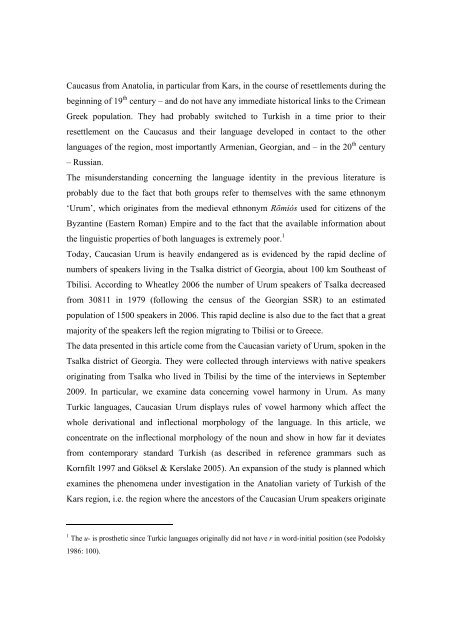
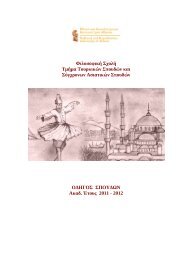
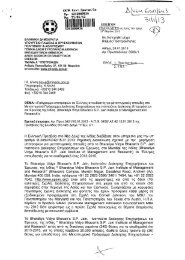
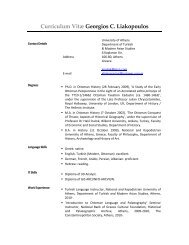
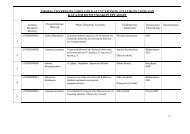

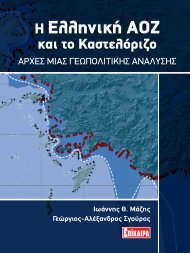
![Panagiotis C. Poulos[cv]](https://img.yumpu.com/6513871/1/190x245/panagiotis-c-pouloscv.jpg?quality=85)